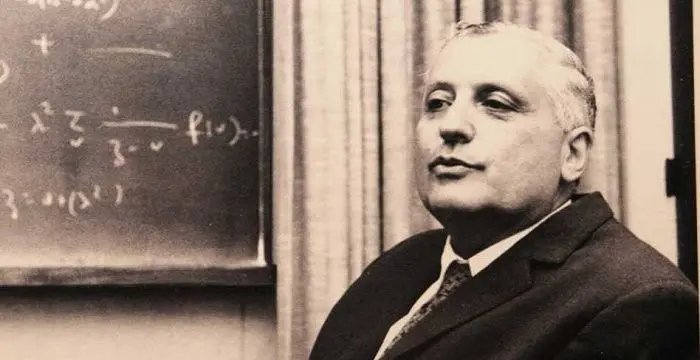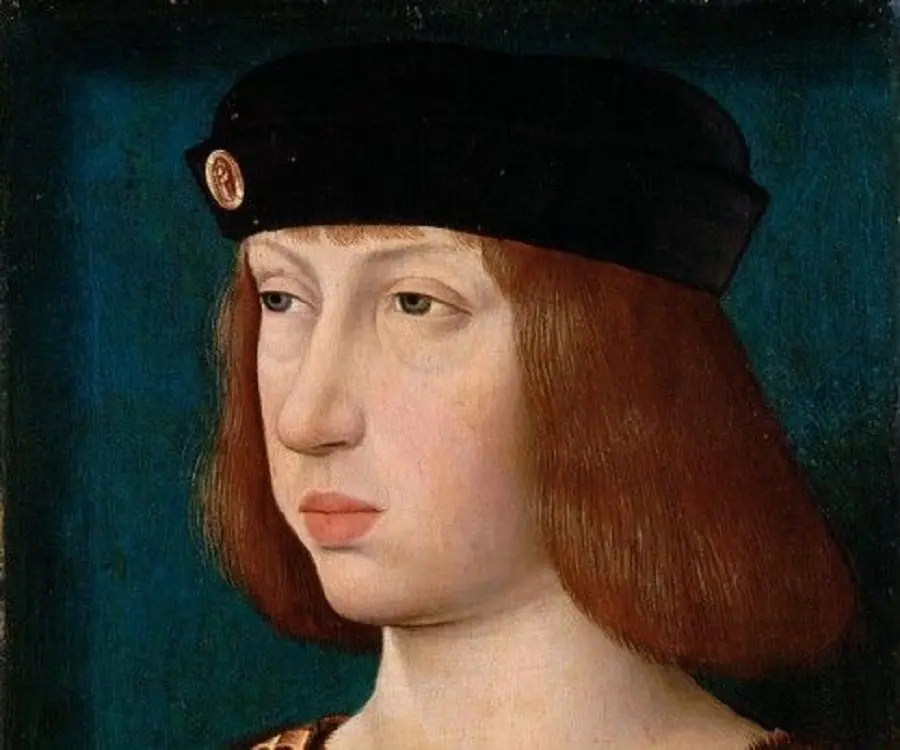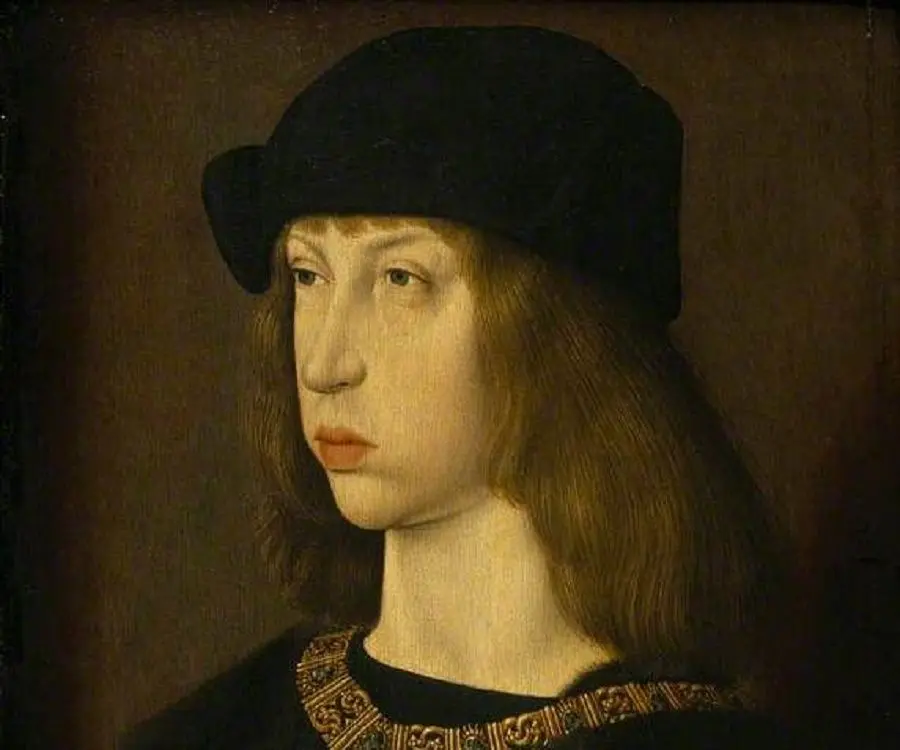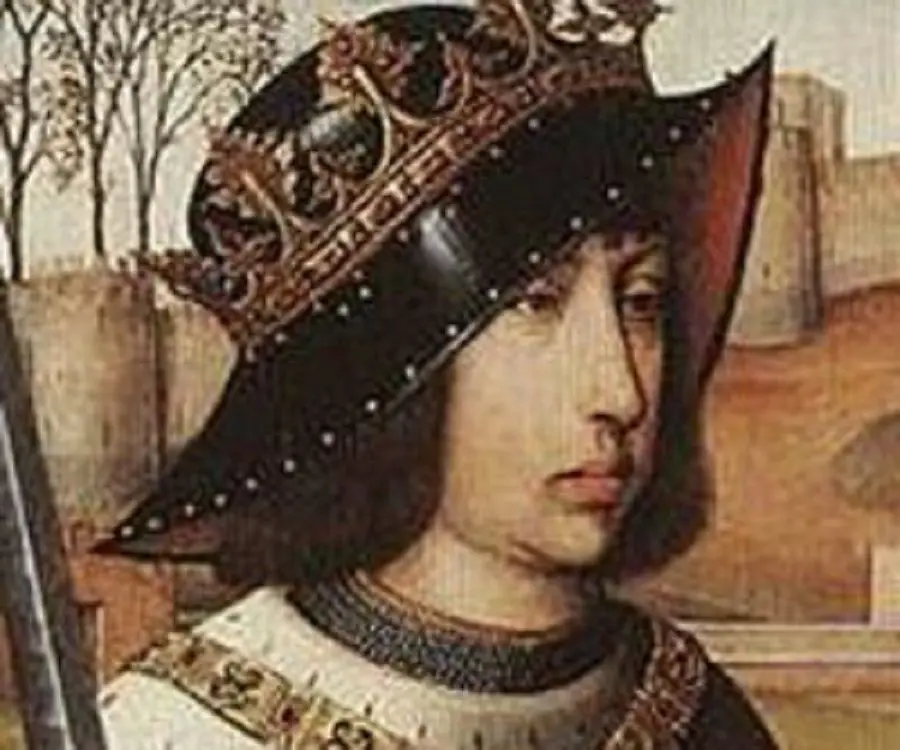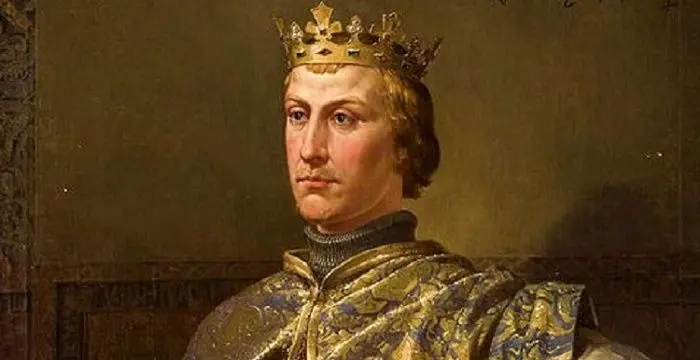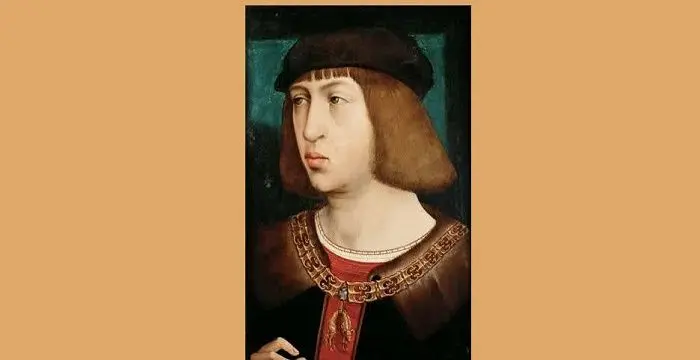
Philip I of Castile - Emperors, Family and Family
Philip I of Castile's Personal Details
Philip I, also called Philip The Handsome, was the first King of Castile from the House of Habsburg
| Information | Detail |
|---|---|
| Birthday | July 22, 1478 |
| Died on | September 25, 1506 |
| Nationality | Belgian |
| Famous | Historical Personalities, Emperors & Kings, Belgian Men, Emperors, King of Castile, Kings |
| Spouses | Joanna of Castile (m. 1496–1506) |
| Known as | Philip I The Handsome, Fair |
| Childrens | Catherine of Austria, Charles V, Eleanor of Austria, Ferdinand I, Holy Roman Emperor, Isabella of Austria, Mary of Hungary, Queen of Portugal |
| Birth Place | Bruges, Belgium |
| Gender | Male |
| Father | Maximilian I, Holy Roman Emperor |
| Mother | Mary of Burgundy |
| Sun Sign | Cancer |
| Born in | Bruges, Belgium |
| Famous as | King of Castile |
| Died at Age | 28 |
// Famous Belgian Men
Stromae
Stromae is a Belgian musician, rapper, singer and songwriter. Check out this biography to know about his birthday, childhood, family life, achievements, and fun facts about him.
Kevin De Bruyne
Kevin De Bruyne is a Belgian footballer who plays for the English Premier League team ‘Manchester City’ as well as the Belgian national team.
Ilya Prigogine
Ilya Prigogine was a Russian-born Belgian physical chemist who was awarded the Nobel Prize for Chemistry in 1977. This biography of Ilya Prigogine provides detailed information about his childhood, life, achievements, works & timeline.
Philip I of Castile's photo
Who is Philip I of Castile?
Philip I, also called Philip The Handsome, was the first King of Castile from the House of Habsburg. He was born to Holy Roman Emperor Maximilian I and his first wife Mary, the Duchess of Burgundy. The latter reigned many territories of the Duchy of Burgundy and the Low Countries. After Mary‘s death, Philip I inherited his mother’s dominions under the guardianship of his father. His father married him to Joanna of Castile, the second daughter of Ferdinand II, ruler of Aragon and Isabella I, ruler of Castile. Following Isabella‘s death, Joanna became queen regent. However, her mental incapacitation added with Ferdinand II’s efforts in laying hands on the regency of Castile led the nobles to summon Philip I to Spain and proclaim him jure uxoris King of Castile in 1506. He, however, died after a couple of months, arousing doubts of foul play by Ferdinand. He could not inherit his father’s dominions to become Holy Roman Emperor as the latter was still alive. His son Charles later ruled the lands of the former Duchy of Burgundy, the Holy Roman Empire as Charles V and the Spanish Empire as Charles I. Philip I, still considered as progenitor of all later monarchs of Spain, is regarded to have played a vital role in extending the territories of the House of Habsburg.
// Famous Emperors
Sundiata Keita
Sundiata Keita was the founder of the Mali Empire in West Africa. This biography profiles his childhood, early life, struggles, founding of empire, rule, administration, achievements and also gives some fun facts.
Ashoka
Ashoka was the third emperor of the Mauryan Dynasty and ruled almost the entire Indian subcontinent. This biography profiles his childhood, life, reign, achievements and timeline
Murad IV
Murad IV was one of the mighty Sultans in the history of the Ottoman Empire. This biography profiles his childhood, family, accession, rule, administration and timeline.
Birth
Philip I was born on July 22, 1478, in Bruges, Flanders, Burgundian Netherlands, to future Maximilian I, Holy Roman Emperor and his first wife Mary, Duchess of Burgundy.
His grandfather Frederick III ruled the empire at the time of his birth. He was named after his mother’s grandfather Philip the Good.
Burgundian Inheritance
His mother, Mary, who ruled over many territories of the Duchy of Burgundy and the Low Countries, died on March 27, 1482 when he was just four years old. As a result of this, he inherited all her dominions under his father’s guardianship. A tumultuous period followed that saw on and off conflicts, mainly between those who backed Maximilian I and the large towns of Flanders.
The cities of Flanders revolted against Maximilian I twice during 1482–1492 to back their claims of greater power which they seized from Mary through the ‘Great Privilege’ instrument signed by her on February 11, 1477. Such interregnum period also saw Philip I being sequestered for a short while in Bruges as part of the revolt.
The revolts, however, became unsuccessful with Flemish cities compelled to accept Maximilian I as regent. The two sides came to terms with the ‘Treaty of Senlis’ related to the Burgundian succession. It was signed between Maximilian I and King Charles VIII of France in May 1493 at Senlis, Oise. It was agreed that Philip I will become prince in the next year.
According to the Treaty of Senlis, Maximilian I gave up his regency in 1494 while the 16 years old Philip I began to rule the Burgundian lands. However, the power was practically exercised by a council of Burgundian notables.
Alliance With Spain
Meanwhile, the policies of King of France Louis XI and also the successful assertion of regal power against the alliance of feudal nobles, the ‘League of the Public Weal’, arranged in 1465 to defy the King’s centralized authority, saw considerable rise in power of France.
In pursuit of blocking the soaring power of France, the Habsburgs and the Trastámara went into a set of family alliances. As a result Maximilian I got Philip I married to Joanna on October 20, 1496 in Lier, Belgium. She was the third child and second daughter of King Ferdinand II of Aragon and Queen Isabella I of Castile
His sister Margaret was also married off to the only son of Ferdinand II and Isabella I, John, Prince of Asturias. At the time John was the heir apparent to the crowns of Aragon and Castile with his sisters Isabella, wife of Manuel I of Portugal, and Joanna second and third in line respectively.
Castilian Crown to Joanna
On October 4, 1497 John, the heir apparent of the Castilian and Aragonese crowns died. On December 8 of that year his wife Margaret gave birth to a stillborn girl. His elder sister Isabella died while giving birth to her son, Miguel da Paz in 1498.
Miguel da Paz thus became the heir of the kingdoms of Aragon, Castile and León through his mother and also heir of his father’s kingdom of Portugal. However, the Portuguese royal infant died on July 19, 1500, following which Joanna became the heir of the united crowns of Castile and Aragon.
Although the Cortes of Aragon did not acknowledge Joanna as heir apparent to the Aragonese crown, this was not the case for the Kingdom of Castile. With the succession of the Spanish crown passing on to his wife, Philip I proclaimed himself and Joanna the 'Princes of Castile', which King Ferdinand II and Queen Isabella I regarded as disrespect towards their deceased son.
However, the subject of supposed mental incompetence of Joanna leading to a probable shift of power of Castile to Philip I and his Burgundian entourage eventually became an issue. The couple along with a Burgundian entourage went to Spain in 1502 to get fealty from the Cortes of Castile.
The following year Philip I and most of his Burgundian entourage went back to the Low Countries. He left pregnant Joanna in Madrid where on March 10, 1503, she gave birth to her fourth child Ferdinand I who later became Holy Roman Emperor, king of Bohemia and Hungary.
Despite Joanna’s intense love for her husband, the couple was considered to have led an unhappy conjugal life due to infidelity and political insecurity of the latter.
Philip I had tried several times to seize legal birthrights of power of Joanna including coercing and imprisoning her. Reports of depressive or neurotic acts of Joanna observed during such period aided in escalating rumours of her insanity. The couple started living separately even before her mother’s death in 1504.
Many modern day historians are of the opinion that Joanna was just clinically depressed which was commonly misbelieved as her insanity.
As King of Castile
Following Queen Isabella I’s death on November 26, 1504, Joanna became Queen regnant of Castile. Although Ferdinand II lost his monarchical status in Castile, according to the will of Isabella I, he was allowed to govern in the absence of Joanna or in case the latter was not willing to rule herself until her heir reached 20 years of age.
Ferdinand II’s endeavour to retain regency of Castile permanently was not taken well by the Castilian nobility who compelled him to withdraw and summoned Philip I to Spain to proclaim him as King.
While on their way to Spain to claim the Castilian inheritance and respond to the summon of Castilian nobility, Philip I and Joanna met with a wild storm in January 1506 which forced them to halt on the shore near Melcombe Regis.
The couple had to sojourn as guests of Henry VII of England, but in reality they remained as a hostage during that period until Philip I signed the Intercursus Malus treaty with Henry VII that was intended to replace the Intercursus Magnus treaty of February 1496.
Intercursus Malus was too advantageous for the English. It included a trade agreement allowing English merchants to import duty free cloth into the Low Countries. The treaty also had a clause to extradite rebels including Edmund de la Pole who was living as guest of Philip I in the Low Countries following his exile. After Philip I handed over Edmund, he was allowed to leave with his wife.
On April 28, 1506, Philip I and Joanna along with a body of German mercenaries reached Corunna. Philip I and Ferdinand II tried to resolve things under Cardinal Cisneros at Remesal and at Renedo. However, such pursuits only resulted in distasteful family altercations with Ferdinand II making vows to protect his daughter’s interests accusing Philip I of imprisoning her.
Ferdinand II and Philip I then signed the Treaty of Villafáfila on June 27, 1506 that saw the former ceding all power to Philip I and retiring to Aragon while the latter being proclaimed jure uxoris King of Castile by the Cortes of Valladolid.
Sudden Death
On September 25, 1506 Philip I suddenly died of typhoid fever at Burgos. As the death was sudden, many believed that Ferdinand II got him poisoned. At that time Joanna was pregnant with their sixth child, Catherine.
He is entombed at the Royal Chapel of Granada where Joanna, Ferdinand II and Isabella I are also entombed.
Children With Joanna
He had six children with Joanna namely Eleanor (1498–1558); Charles V (1500–1558), Holy Roman Emperor and king of Spain; Isabella (1501–1526); Ferdinand I (1503–1564), Holy Roman Emperor and king of Bohemia and Hungary; Mary (1505–1558); and Catherine (1507–1578).
// Famous Kings
Sundiata Keita
Sundiata Keita was the founder of the Mali Empire in West Africa. This biography profiles his childhood, early life, struggles, founding of empire, rule, administration, achievements and also gives some fun facts.
Ashoka
Ashoka was the third emperor of the Mauryan Dynasty and ruled almost the entire Indian subcontinent. This biography profiles his childhood, life, reign, achievements and timeline
Murad IV
Murad IV was one of the mighty Sultans in the history of the Ottoman Empire. This biography profiles his childhood, family, accession, rule, administration and timeline.
Philip I of Castile biography timelines
- // 1465Meanwhile, the policies of King of France Louis XI and also the successful assertion of regal power against the alliance of feudal nobles, the ‘League of the Public Weal’, arranged in 1465 to defy the King’s centralized authority, saw considerable rise in power of France.
- // 22nd Jul 1478Philip I was born on July 22, 1478, in Bruges, Flanders, Burgundian Netherlands, to future Maximilian I, Holy Roman Emperor and his first wife Mary, Duchess of Burgundy.
- // 27th Mar 1482His mother, Mary, who ruled over many territories of the Duchy of Burgundy and the Low Countries, died on March 27, 1482 when he was just four years old. As a result of this, he inherited all her dominions under his father’s guardianship. A tumultuous period followed that saw on and off conflicts, mainly between those who backed Maximilian I and the large towns of Flanders.
- // May 1493The revolts, however, became unsuccessful with Flemish cities compelled to accept Maximilian I as regent. The two sides came to terms with the ‘Treaty of Senlis’ related to the Burgundian succession. It was signed between Maximilian I and King Charles VIII of France in May 1493 at Senlis, Oise. It was agreed that Philip I will become prince in the next year.
- // 1494According to the Treaty of Senlis, Maximilian I gave up his regency in 1494 while the 16 years old Philip I began to rule the Burgundian lands. However, the power was practically exercised by a council of Burgundian notables.
- // Feb 1496The couple had to sojourn as guests of Henry VII of England, but in reality they remained as a hostage during that period until Philip I signed the Intercursus Malus treaty with Henry VII that was intended to replace the Intercursus Magnus treaty of February 1496.
- // 20th Oct 1496In pursuit of blocking the soaring power of France, the Habsburgs and the Trastámara went into a set of family alliances. As a result Maximilian I got Philip I married to Joanna on October 20, 1496 in Lier, Belgium. She was the third child and second daughter of King Ferdinand II of Aragon and Queen Isabella I of Castile
- // 4th Oct 1497 To 1498On October 4, 1497 John, the heir apparent of the Castilian and Aragonese crowns died. On December 8 of that year his wife Margaret gave birth to a stillborn girl. His elder sister Isabella died while giving birth to her son, Miguel da Paz in 1498.
- // 19th Jul 1500Miguel da Paz thus became the heir of the kingdoms of Aragon, Castile and León through his mother and also heir of his father’s kingdom of Portugal. However, the Portuguese royal infant died on July 19, 1500, following which Joanna became the heir of the united crowns of Castile and Aragon.
- // 1502However, the subject of supposed mental incompetence of Joanna leading to a probable shift of power of Castile to Philip I and his Burgundian entourage eventually became an issue. The couple along with a Burgundian entourage went to Spain in 1502 to get fealty from the Cortes of Castile.
- // 10th Mar 1503The following year Philip I and most of his Burgundian entourage went back to the Low Countries. He left pregnant Joanna in Madrid where on March 10, 1503, she gave birth to her fourth child Ferdinand I who later became Holy Roman Emperor, king of Bohemia and Hungary.
- // 1504Philip I had tried several times to seize legal birthrights of power of Joanna including coercing and imprisoning her. Reports of depressive or neurotic acts of Joanna observed during such period aided in escalating rumours of her insanity. The couple started living separately even before her mother’s death in 1504.
- // 26th Nov 1504Following Queen Isabella I’s death on November 26, 1504, Joanna became Queen regnant of Castile. Although Ferdinand II lost his monarchical status in Castile, according to the will of Isabella I, he was allowed to govern in the absence of Joanna or in case the latter was not willing to rule herself until her heir reached 20 years of age.
- // Jan 1506While on their way to Spain to claim the Castilian inheritance and respond to the summon of Castilian nobility, Philip I and Joanna met with a wild storm in January 1506 which forced them to halt on the shore near Melcombe Regis.
- // 28th Apr 1506On April 28, 1506, Philip I and Joanna along with a body of German mercenaries reached Corunna. Philip I and Ferdinand II tried to resolve things under Cardinal Cisneros at Remesal and at Renedo. However, such pursuits only resulted in distasteful family altercations with Ferdinand II making vows to protect his daughter’s interests accusing Philip I of imprisoning her.
- // 27th Jun 1506Ferdinand II and Philip I then signed the Treaty of Villafáfila on June 27, 1506 that saw the former ceding all power to Philip I and retiring to Aragon while the latter being proclaimed jure uxoris King of Castile by the Cortes of Valladolid.
- // 25th Sep 1506On September 25, 1506 Philip I suddenly died of typhoid fever at Burgos. As the death was sudden, many believed that Ferdinand II got him poisoned. At that time Joanna was pregnant with their sixth child, Catherine.
// Famous King of Castile
Peter of Castile
Peter of Castile was the king of Castile and León from 1350 to 1369. This biography of Peter of Castile provides detailed information about his childhood, life, achievements, works & timeline.
Philip I of Castile's FAQ
What is Philip I of Castile birthday?
Philip I of Castile was born at 1478-07-22
When was Philip I of Castile died?
Philip I of Castile was died at 1506-09-25
Which age was Philip I of Castile died?
Philip I of Castile was died at age 28
Where is Philip I of Castile's birth place?
Philip I of Castile was born in Bruges, Belgium
What is Philip I of Castile nationalities?
Philip I of Castile's nationalities is Belgian
Who is Philip I of Castile spouses?
Philip I of Castile's spouses is Joanna of Castile (m. 1496–1506)
Who is Philip I of Castile childrens?
Philip I of Castile's childrens is Catherine of Austria, Charles V, Eleanor of Austria, Ferdinand I, Holy Roman Emperor, Isabella of Austria, Mary of Hungary, Queen of Portugal
Who is Philip I of Castile's father?
Philip I of Castile's father is Maximilian I, Holy Roman Emperor
Who is Philip I of Castile's mother?
Philip I of Castile's mother is Mary of Burgundy
What is Philip I of Castile's sun sign?
Philip I of Castile is Cancer
How famous is Philip I of Castile?
Philip I of Castile is famouse as King of Castile


